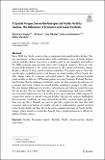Files in this item
A spatial perspective on the unexpected Nordic fertility decline : the relevance of economic and social contexts
Item metadata
| dc.contributor.author | Campisi, Nicholas | |
| dc.contributor.author | Kulu, Hill | |
| dc.contributor.author | Mikolai, Julia | |
| dc.contributor.author | Klüsener, Sebastian | |
| dc.contributor.author | Myrskylä, Mikko | |
| dc.date.accessioned | 2022-07-08T08:30:06Z | |
| dc.date.available | 2022-07-08T08:30:06Z | |
| dc.date.issued | 2022-07-06 | |
| dc.identifier | 280149459 | |
| dc.identifier | 622834ba-bd5a-45fa-a6da-ac524a90e7d3 | |
| dc.identifier | 85133568740 | |
| dc.identifier | 000821362400001 | |
| dc.identifier.citation | Campisi , N , Kulu , H , Mikolai , J , Klüsener , S & Myrskylä , M 2022 , ' A spatial perspective on the unexpected Nordic fertility decline : the relevance of economic and social contexts ' , Applied Spatial Analysis and Policy , vol. First Online . https://doi.org/10.1007/s12061-022-09467-x | en |
| dc.identifier.issn | 1874-463X | |
| dc.identifier.other | ORCID: /0000-0002-7733-6659/work/115630932 | |
| dc.identifier.other | ORCID: /0000-0001-8808-0719/work/115630976 | |
| dc.identifier.uri | https://hdl.handle.net/10023/25633 | |
| dc.description | Open Access funding enabled and organized by Projekt DEAL. | en |
| dc.description.abstract | Since 2010, the Nordic countries have experienced substantial fertility decline. This was unexpected, as these countries have well-established systems of family support policies and they did not experience a fertility shock in the immediate aftermath of the 2008 economic recession like many other European countries. Previous studies paid little attention to the spatial dimension of this unexpected fertility change, despite evidence of large spatial variation in fertility. This paper aims to close this gap through a spatial perspective and deepen our understanding of how Nordic fertility change varies by economic and social contexts. We apply advanced spatial panel models on data for 1,099 municipalities covering Denmark, Finland, Norway, and Sweden. Next to analyzing total fertility rates, we also compare the relevance of economic and social contexts for spatial fertility variation at younger or older ages. We note distinct differences by levels of urbanization and differing trends between the age groups. We also find that measures of unemployment and union stability are associated with lower levels of fertility across space and time, while support for conservative parties is related to higher fertility. Age-specific analyses highlighted that economic conditions are more relevant for fertility variation under age thirty than over age thirty. Overall, our analysis provides support for the view that both economic and social factors are highly relevant for understanding spatial variation in the Nordic fertility decline. Given the strong spatial component in Nordic fertility change, policy initiatives would also benefit from a spatial dimension to effectively address fertility change. | |
| dc.format.extent | 1338076 | |
| dc.language.iso | eng | |
| dc.relation.ispartof | Applied Spatial Analysis and Policy | en |
| dc.subject | Decline | en |
| dc.subject | Economic context | en |
| dc.subject | Fertility | en |
| dc.subject | Nordic | en |
| dc.subject | Social contexts | en |
| dc.subject | Spatial regression | en |
| dc.subject | HM Sociology | en |
| dc.subject | 3rd-DAS | en |
| dc.subject | SDG 8 - Decent Work and Economic Growth | en |
| dc.subject | SDG 11 - Sustainable Cities and Communities | en |
| dc.subject.lcc | HM | en |
| dc.title | A spatial perspective on the unexpected Nordic fertility decline : the relevance of economic and social contexts | en |
| dc.type | Journal article | en |
| dc.contributor.institution | University of St Andrews. Population and Health Research | en |
| dc.contributor.institution | University of St Andrews. Sir James Mackenzie Institute for Early Diagnosis | en |
| dc.contributor.institution | University of St Andrews. School of Geography & Sustainable Development | en |
| dc.contributor.institution | University of St Andrews. Geographies of Sustainability, Society, Inequalities and Possibilities | en |
| dc.identifier.doi | https://doi.org/10.1007/s12061-022-09467-x | |
| dc.description.status | Peer reviewed | en |
This item appears in the following Collection(s)
Items in the St Andrews Research Repository are protected by copyright, with all rights reserved, unless otherwise indicated.

